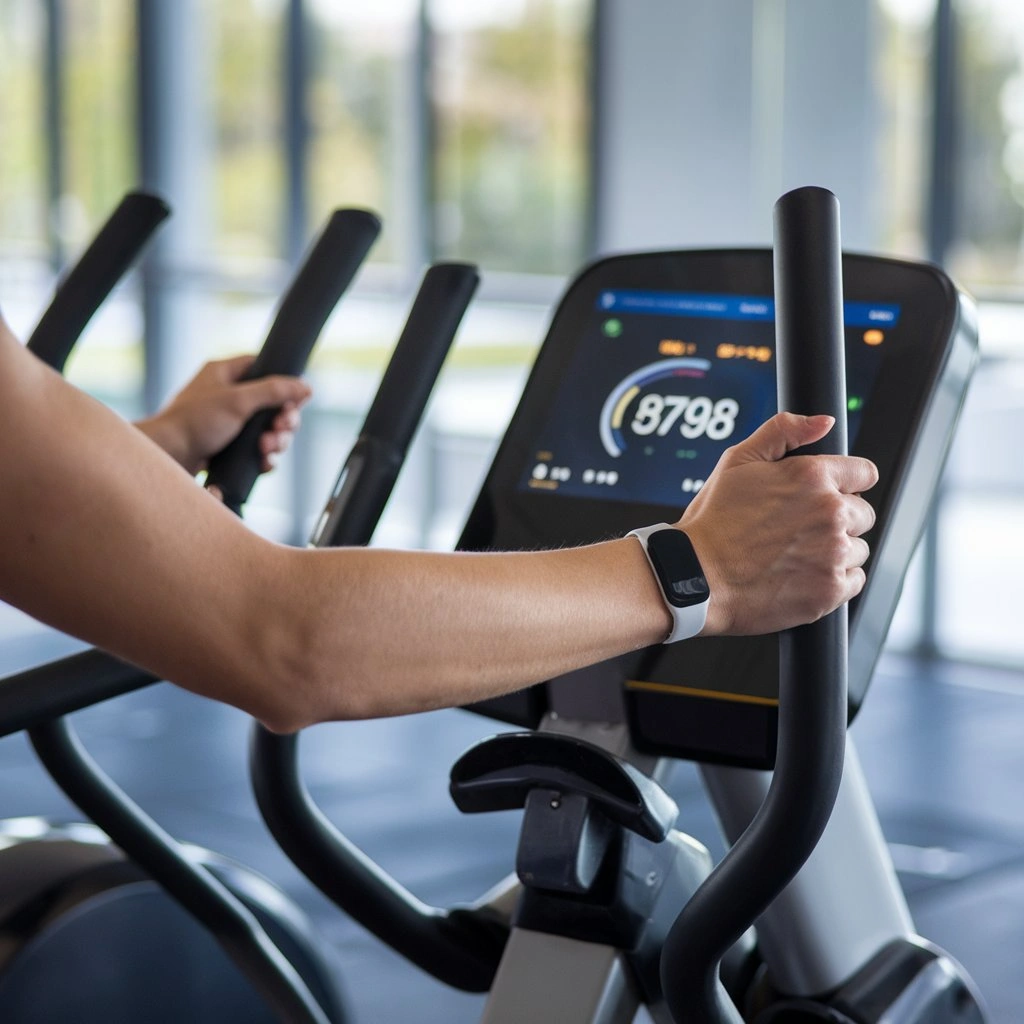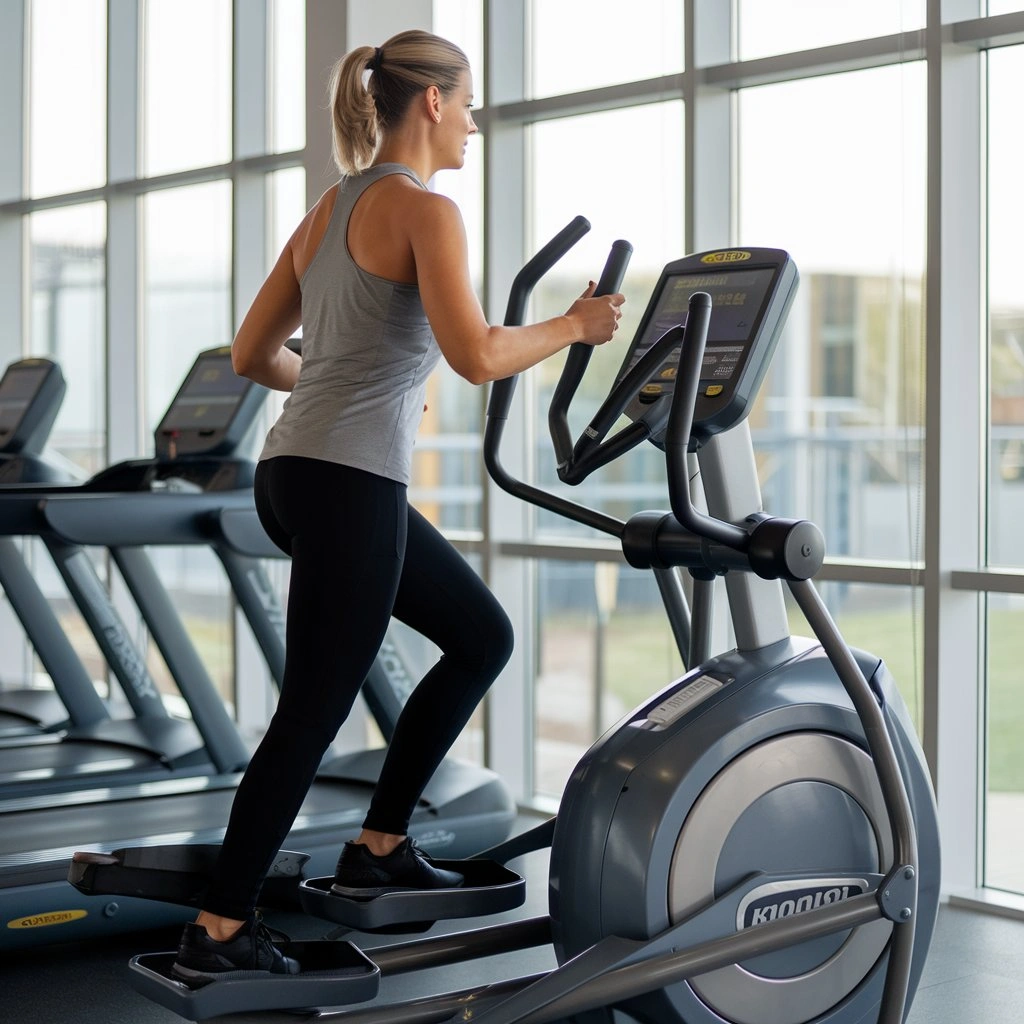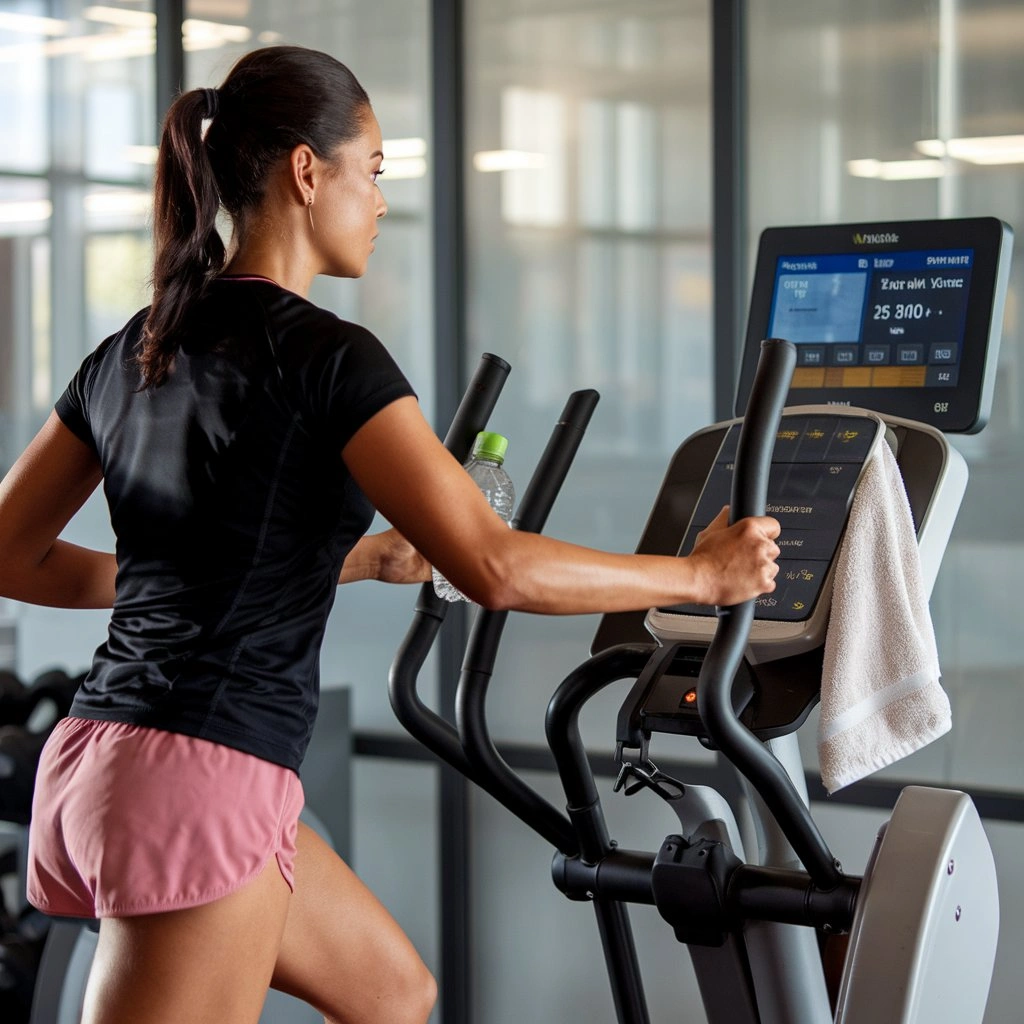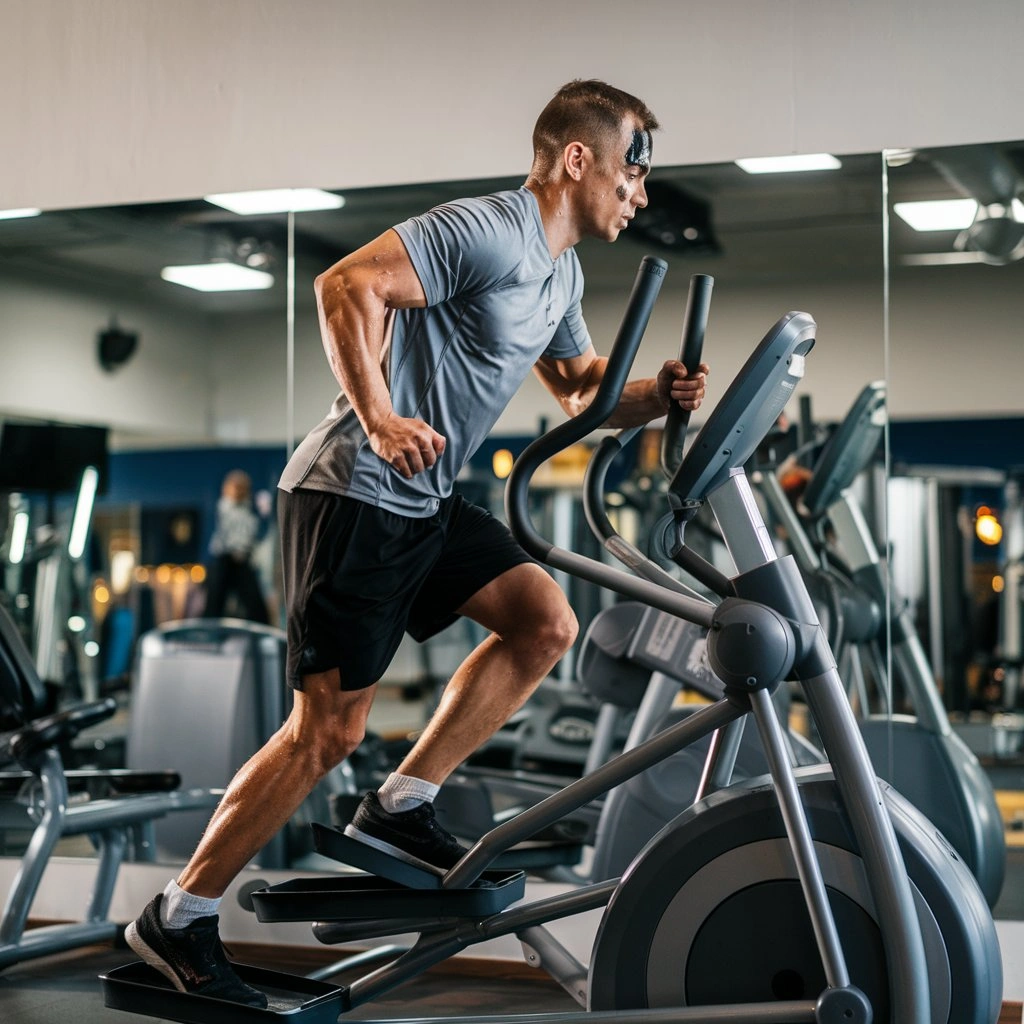Have you ever used an elliptical trainer at the gym and wondered, “How many calories am I burning?” You’re not alone! People like elliptical machines for cardio. They are low-impact on your joints but still offer a great workout. But figuring out exactly how many calories you burn can be tricky.
This guide will be your one-stop shop for all things Calories Burned on the elliptical! We’ll simplify it into the following steps:
- In this introduction, we’ll talk about why tracking your burned calories is important. We’ll also cover how to get a rough estimate for your elliptical workouts.
- Part II covers the Elliptical Machine. We’ll dive into how it works. And, how different mechanics affect your calorie burn.
Why Track Elliptical Calories?
Tracking your calorie burn helps you stay motivated! Seeing a number lets you know how hard you’re working and how close you are to reaching your fitness goals. You may want to lose weight, build endurance, or get healthier. Knowing your calorie burn helps you adjust your workout. It helps you get the best results.
Estimating Elliptical Calories – The Quick and Easy Way
Most gyms have elliptical machines. They have built-in displays that estimate your Calorie Burn. Your weight, height, age, and workout time determine the estimate. These numbers are a good starting point, but they may not be completely accurate. Don’t worry, we’ll refine that estimate in the next section!
 Understanding the Elliptical Machine
Understanding the Elliptical Machine
The elliptical trainer is a popular gym buddy, but have you ever wondered how it works? Let’s dive in and understand this awesome machine!
Elliptical Motion Explained (No Math Needed!)
Imagine yourself running or walking, but without your feet ever leaving the pedals. That’s the basic idea behind the elliptical. Your legs move in an oval path. This mimics natural running but without impact on your joints. This makes it a great option for people who want a cardio workout that’s easier on their knees, ankles, and back.
Burning Calories on the Elliptical: It’s All About You!
The elliptical is a fantastic calorie burner, but how many calories you burn depends on a few things:
- Intensity: You burn more calories when you exert yourself more. This means increasing your stride length (how far your feet move) and resistance level. Think of it like climbing a hill – steeper hills burn more calories!
- Heavier people tend to burn more calories. This is because their bodies need more energy to move.
Bonus Tips to Maximize Your Elliptical Workout
- Warm Up: Before you jump on, spend a few minutes on light cardio. Do things like slow pedaling or arm circles. They will get your blood flowing and your muscles warm.
- Posture Matters: Keep your back straight, core engaged, and shoulders relaxed. Imagine a straight line from your head down to your heels.
- Work Your Upper Body: Many ellipticals have moving handles. Use them to pump your arms and engage your upper body for a more complete workout.
- Mix things Up: Avoid becoming complacent.! Try interval training, where you alternate between high-intensity bursts and recovery periods. This keeps your workout interesting and burns more calories.
- Pay Attention to Your Body: Avoid overexerting yourself, particularly in the beginning. Take breaks when you need them and stop if you feel any pain.
Methods of Calculating Calories Burned on The Elliptical
Ever hopped off the elliptical wondering exactly how many calories you torched? You’re not alone! It’s easy to get lost in a good workout playlist. But, many of us wonder about the calories this popular exercise machine burns.
This guide will reveal how to calculate calories burned on an elliptical trainer. They will empower you to track your fitness progress. We’ll explore two main approaches. The first is manual calculations. The second is using the elliptical machine’s metrics.
Manual Calculations: Math for Fitness Fanatics
For those who love a good calculation, here’s how to estimate calorie burn. You can use a scientific formula.
The Basic Formula
The magic equation for calorie burn involves MET (Metabolic Equal of Task) values. MET represents how much energy your body uses compared to sitting still. Here’s the formula:
MET x Weight (kg) x Time (minutes) / 60 = Calories Burned
MET Values for Elliptical Workouts
The MET value depends on the intensity of your workout. Here’s a cheat sheet to get you started:
- Low Intensity (Light Effort): 3.0 METs (Think of a stroll)
- Moderate Intensity (Moderate Effort): 5.0 METs (Think of a brisk walk)
- High Intensity (Vigorous Effort): 7.0 METs (Think of jogging or running)
Example Calculation
Let’s say you weigh 70 kg and exercise on the elliptical for 30 minutes at a moderate intensity (5.0 METs).
5.0 METs x 70 kg x 30 minutes / 60 = 175 calories burned
Using Elliptical Machine Metrics: Convenience at Your Fingertips
Most ellipticals have built-in calorie counters. They give an instant estimate of your burn. Here’s how to leverage this technology:
Built-in Calorie Counters
These counters consider factors like your weight and the time. Sometimes, they even use heart rate. They use these factors to give you a calorie burn reading.
Pros: Convenient and easy to use. No complex calculations are needed.
Cons: It may not be very accurate. This is especially true if you don’t enter your weight. Or if your workout intensity varies.
Heart Rate Monitors
Heart rate monitors track your heart rate during exercise. Since your heart rate rises as you exert yourself, it can be a good indicator of calorie burn.
Pros: Provides real-time feedback on your workout intensity.
Cons: Doesn’t measure calorie burn. Requires more equipment (heart rate check strap).
Remember, whatever method you choose. The key is that calorie burn estimates are that. They are estimates. Several factors can influence your actual calorie burn, including:
- Body Composition: People have more muscle. They tend to burn more calories at rest and during exercise.
- Fitness Level: Fitter individuals tend to burn calories more.
- Diet: What you eat also plays a role.
Maximizing Your Elliptical Workout
Here are some tips to boost your calorie burn and get the most out of your elliptical sessions:
- Increase Intensity: Push yourself by upping the resistance or incline level.
- Interval Training: Alternate between high-intensity bursts and recovery periods.
- Engage Your Upper Body: Use the moving handles to work your arms and core.
- Maintain proper form. Keep your back straight and core engaged. This is best for burning calories and preventing injury.
 Factors Affecting Calorie Burn
Factors Affecting Calorie Burn
Conquering your fitness goals often involves a battle with the calorie gods. Burning more calories than you eat is the key to weight loss. The elliptical trainer is a popular weapon in this fight. But how much firepower does this machine pack? The answer lies in understanding the factors. They stoke the flames of your calorie burn during an elliptical workout.
This guide covers the six main factors that affect how many calories you burn on the elliptical:
Intensity of Workout: The Engine of Calorie Burn
The intensity of your workout is like the fuel you pour on the calorie-burning fire. Here’s how intensity plays out:
- Low Intensity (Light Effort): Imagine a stroll on a flat path. This burns the fewest calories. It’s around 3 METs (Metabolic Equal of Task). Think of METs as a unit of measurement for how hard your body works compared to sitting still.
- Moderate Intensity (Moderate Effort): Picture a brisk walk with some effort. This sweet spot burns more calories, about 5 METs. It also has a good balance between effort and sustainability.
- High Intensity (Vigorous Effort): Think of jogging or running on an inclined elliptical. This burns the most calories (around 7 METs or higher) but requires a higher level of fitness.
Duration of Exercise Session: The Longer You Burn, the More You Earn
Think of your workout’s duration as the time you spend tending a bonfire that burns calories. The longer you exercise, the more calories you burn, even at a moderate intensity. Here’s a breakdown:
- Shorter workouts (15-20 minutes) are good for beginners. But, they burn fewer calories — about 100-200.
- Moderate workouts last 30-45 minutes. This is a golden zone. They burn many calories (around 200-400) and need a reasonable time for most people.
- Longer workouts (45+ minutes) burn the most calories (about 400+). But, they must have a strong fitness base and proper hydration to avoid fatigue.
C. Body Weight and Composition: The Bigger the Fire, the More Fuel Needed
Your body weight and composition act like the size of your bonfire. Here’s why:
- Body Weight: Heavier people burn more calories at rest and during exercise. This is because it takes more energy to move a heavier body.
- Muscle Mass: Muscle tissue burns more calories than fat tissue, even at rest. So, people with more muscle will burn more calories on the elliptical. This can be compared to those with less muscle at the same weight.
Resistance Level: Turning Up the Heat
Adjusting the resistance on an elliptical is like moving air vents. More resistance makes the workout harder. It forces your muscles to work more and burn more calories. Here’s how it works:
- Low Resistance: Think of gliding on flat terrain. This burns fewer calories but is a good starting point for beginners.
- Moderate Resistance: Imagine walking uphill with some effort. This provides a good balance between challenge and calorie burn.
- High Resistance: Picture climbing a steep hill or running against strong wind. This burns the most calories but requires a strong fitness level.
Age and Gender: The Simmering Effects of Time and Biology
Age and gender play subtle roles in calorie burn:
- As we age, our metabolism slows down. This leads to a decrease in calorie burning at rest and during exercise.
- Men generally have a higher basal metabolic rate (BMR) than women. They burn more calories at rest. But, these factors can reduce the difference. Factors include muscle mass and exercise intensity.
Fitness Level: The Efficiency Factor
Your fitness level affects how your body burns calories. Here’s the breakdown:
- Your body is still learning to exercise well. So, calorie burn might be lower at first.
- As you get fitter, your body burns calories more. This lets you burn more during your workouts.
- Advanced: Your body is a calorie-burning machine, maximizing calorie burn during exercise.
 Tips for Maximizing Calories Burned On The Elliptical
Tips for Maximizing Calories Burned On The Elliptical
The elliptical trainer is a gym staple. It beckons with promises of a low-impact cardio workout. But are you unlocking its full potential for calorie burning? This guide gives you battle-tested tips. They will turn your elliptical sessions into calorie-crushing infernos!
Interval Training: The Spark that Ignites the Fire
Imagine your workout as a bonfire. Traditional steady-state exercise keeps the fire burning at a constant pace. Interval training is like throwing logs on a fire. It creates bursts of intense flames. These burn more calories. Here’s how it works:
What is Interval Training?
You alternate between periods of hard work and rest. This keeps your heart rate up for longer. It burns more calories during and after your workout (thanks to the “afterburn” effect).
How to Design Your Elliptical Intervals
Warm-up: Start with 5-10 minutes of light pedaling at a low resistance.
Work Intervals: Increase resistance and/or pace for 30 seconds to 2 minutes. Push yourself to a moderate to high effort (70-85% of your max heart rate).
Take recovery intervals. Reduce resistance and/or pace for 30 seconds to 2 minutes. This lets your heart rate recover. It should be at 50-60% of your greatest heart rate.
Cool Down: End with 5-10 minutes of light pedaling. Use low resistance to bring your heart rate down.
Benefits of Interval Training
Burns more calories in a shorter time compared to steady-state exercise.
Boosts metabolism and increases the afterburn effect.
Improves cardiovascular fitness and stamina.
Adds variety and keeps your workout exciting.
Interval Training Examples
Start with short work intervals (30 seconds). Then, take longer recovery periods (1 minute). increase work intervals and decrease recovery time as you get fitter.
Intermediate: Try 45-second work intervals with 45-second rest periods. Adjust the duration based on your fitness level.
Advanced: Push yourself with 1-minute work intervals and 30-second rest periods.
Adjusting Resistance Levels: Turning Up the Heat
Think of the resistance level on your elliptical as the air vent. It controls your calorie-burning bonfire. More resistance makes the workout tougher. It forces your muscles to work harder and burn more calories. Here’s how to leverage resistance:
- Start Low, Go High: Beginners, start with a low resistance to learn proper form and build endurance. increase resistance as you get stronger.
- Vary the Resistance: Don’t settle for a flat workout. Incorporate hills by increasing resistance at intervals, simulating climbing terrain.
- Target Different Muscle Groups: Change your pedaling technique to target different muscle groups. For example, focus on quads by pushing down through your heels. Engage your glutes by doing a slight hip thrust with each pedal stroke. Engaging larger muscle groups, like the quads and glutes, burns more calories.
Maintaining Proper Form: Stoking the Fire
Proper form ensures you get the most out of your workout and avoids injury. Imagine proper form as tending to your calorie-burning bonfire. You make sure the flames burn well.
- Posture: Keep your back straight, core engaged, and shoulders relaxed. Avoid slouching or hunching forward.
- Use a natural stride length, like when you walk or run. Don’t overextend your legs.
- Arm Movement: Use the arm handles to pump your arms back and forth in coordination with your legs. This engages your upper body and increases calorie burn.
- Focus on Technique: Don’t let momentum take over. Focus on controlled movements and pushing with your legs, not bouncing.
Monitoring Heart Rate: Keeping an Eye on the Flames
Your heart rate is a valuable tool. It gauges your workout intensity and maximizes calorie burn. Think of it as a temperature gauge for your calorie-burning bonfire:
- Target Heart Rate Zones: Different heart rate zones correspond to different exercise intensities. Such a workout burns the most calories per minute. It is moderate-intensity and falls within the 60-80% of your max heart rate zone.
- Finding Your Greatest Heart Rate: A simple formula is 220 minus your age. But, we recommend asking a doctor before starting a new exercise. This is an estimate.
Potential Limitations and Considerations
The elliptical trainer is a popular cardio choice, but is it all sunshine and calorie burn? Let’s delve into some potential limitations and considerations to keep in mind:
Calorie Counter Cautions
The tempting calorie counters on ellipticals can motivate. But, they might not always be accurate. Here’s why:
- Input Matters: These counters rely on your weight and sometimes even your age and gender. Entering inaccurate information will lead to skewed calorie burn estimates.
- They might not capture your workout’s intensity well. This is especially true if you change resistance or pace often.
- Metabolism Mystery: Individual variations in metabolism play a role. Someone with a higher metabolism might burn more calories than the counter predicts. The opposite is true for someone with a lower metabolism.
The Metabolism Maze
Metabolism is the rate your body burns calories. It does so at rest and during exercise. Metabolism is a complex maze with variations. Here’s how it can affect your elliptical experience:
- Muscle Advantage: Muscle tissue burns more calories than fat tissue, even at rest. This means a person with more muscle might burn more calories on the elliptical. Someone weighing the same but with less muscle can be compared to this.
- As we age, our metabolism slows down. This leads to burning fewer calories at rest and during exercise.
A Spectrum of Exercise Options
The elliptical is a fantastic tool, but it’s not the only path to fitness. Here’s how it stacks up against other exercise options:
- Strength training builds muscle. It can boost your metabolism and increase calorie burning at rest.
- High-Intensity Interval Training (HIIT) burns more calories in less time. HIIT workouts, like sprinting or burpees, are an example. They can burn more calories than steady-state exercise on the elliptical.
- Full-body workouts burn more calories than the elliptical. They engage in many muscle groups, like swimming or circuit training. The elliptical targets lower body muscles.
 Maximizing Your Fitness Journey
Maximizing Your Fitness Journey
While the elliptical has limitations, it’s still a valuable tool. Here’s how to get the most out of it:
- Combine Exercises. Pair your elliptical sessions with strength training or HIIT workouts. This makes for a more well-rounded fitness routine.
- Focus on Intensity. Push yourself on the elliptical by raising the resistance. Use interval training. Also, add arm movements for a full-body workout.
- Consult a Doctor. Discuss your fitness goals and health concerns with a doctor. Do this before starting a new exercise program.
Conclusion
So, you’ve started a journey to conquer your fitness goals. The elliptical calls as a trusty companion. But how many calories does this machine incinerate?
Unveiling the answer involves understanding how to calculate calorie burn. You must also understand the factors that influence it. Buckle up, because we’re about to break down the science behind the sweat!
Why Counting Calories Matters
Tracking calorie burn helps you see your energy use more. This knowledge empowers you to create a calorie balance. You must burn more calories than you consume. This balance is essential for weight loss or management. Knowing your calorie burn on the elliptical lets you adjust your diet. You can also adjust your exercise routine.
The Calorie Burn Calculation Cauldron
Several factors simmer in the cauldron of calorie burn during an elliptical workout:
- Intensity: The harder you push yourself, the higher your calorie burn. Think of it like stoking the fire with increased resistance or pace.
- Duration: The longer you exercise, the more calories you burn, even at a moderate intensity. A longer workout extends the time your body burns fuel.
- Body Composition: People with more muscle burn more calories. This is due to the higher metabolic demands of muscle.
- Age and Gender: These play a subtle role. Metabolism slows with age. Men burn more calories than women.
- Fitness Level: Fitter people burn calories more. This leads to a higher calorie burn during exercise compared to beginners.
The Methods to Measure the Magic
We explored two main approaches to calculate calorie burn on the elliptical:
- You can use manual calculations. They rely on the MET (Metabolic Equal of Task) formula. It gives a scientific estimate. This method requires your weight, exercise duration, and intensity (MET value).
- Elliptical Machine Metrics: Built-in calorie counters offer a handy estimate. But, their accuracy can vary based on the info you enter and your workout’s intensity. You can also use heart rate monitors. Heart rate rises with effort, indicating higher calorie burn.
Embrace the Elliptical Adventure
Now you know how to calculate calorie burn and the factors that affect it. You’re ready to unleash the elliptical’s full potential! Remember, consistency is key. Regular elliptical workouts are powerful. They, plus a balanced diet, can help you achieve your fitness goals. So, lace up your shoes, crank up the intensity, and let the calorie-burning journey begin!

